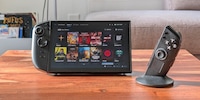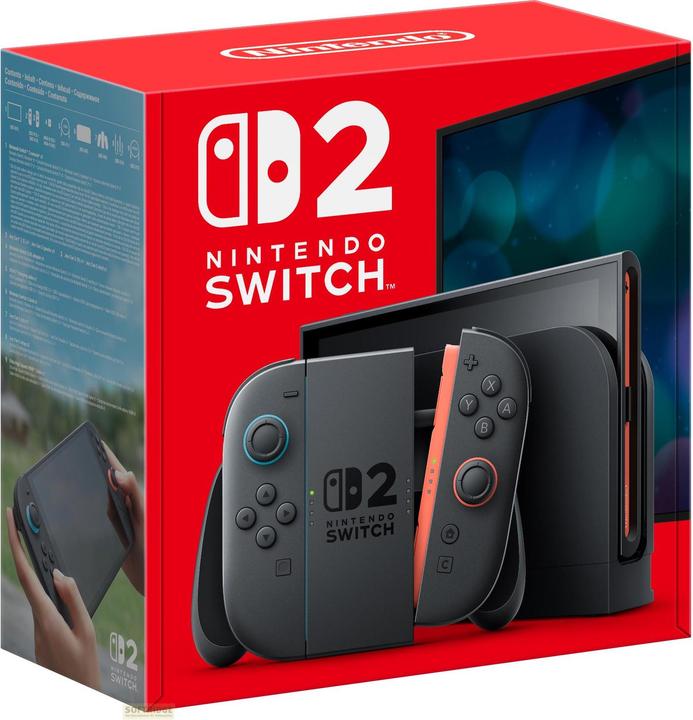
Nintendo Switch 2 tested in detail: useful innovations and annoying weaknesses
The Switch 2 is what I wanted: a bigger, faster and generally better Switch. The handheld convinces with many useful improvements and disappoints with some annoying weaknesses.
I spent two weeks with the Switch 2 and spent several hours a day gaming on the stylish console. Nintendo's next-gen handheld makes an excellent impression. However, the display, which is too dark and prone to scratches, and the lousy battery dampen my enjoyment of the new hardware.
Note: In the video embedded above, you can not only see my impressions after two weeks of using the Switch 2. Also Michelle, Simon and Phil have been busy gaming with the console and will tell you what has excited and annoyed them the most so far.
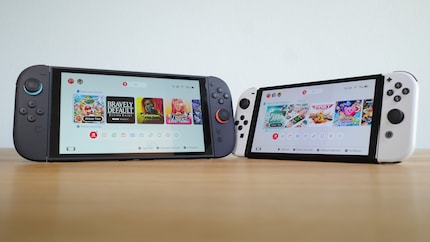
Sleek, elegant design
Nintendo is not reinventing the wheel with the Switch 2, but is consistently developing the Switch concept further. The successor console also functions as a handheld-console hybrid, which I can use both at home on the TV and on the go as a mobile gaming device.
The design of the console is also based on the previous models. With its matte, dark finish and subtle splashes of colour under the analogue sticks, the Switch 2 looks a little more «grown-up» than the original Switch and the OLED model.
Compared to the often monstrous PC handhelds, the Switch 2 looks elegant with its sleek design. Despite the huge screen (7.9 inches), the Switch 2 is thinner, smaller and lighter than, for example, the Rog Ally (7 inches) or the Steam Deck OLED (7.4 inches).
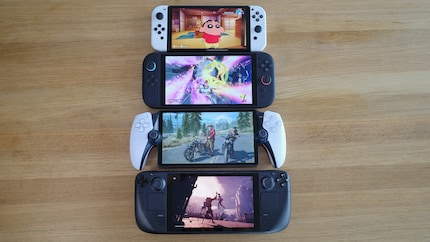
Nintendo's focus on simple design has one disadvantage: Like its predecessors, the Switch 2 is completely flat. It has no protrusions or handles like other handhelds have.
I don't mind that. Thanks to the larger surface area, the console sits very comfortably in my hands in handheld mode. Even after several hours of gaming sessions, my fingers don't get tired or cramp up - that was different with the smaller Switch 1.
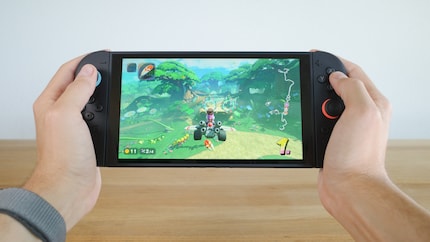
However, if you're used to ergonomic grips (like the PC handheld gamer Phil) or have small hands (such as Michelle), you won't find the Switch 2 as comfortable as I do.
After all, with the improved and amazingly flexible kickstand, you can easily use the console on the go in tabletop mode and game with the more comfortable Pro-Controller or alternatives instead. And thanks to the second USB-C port on the top of the console, it can be charged in tabletop mode.
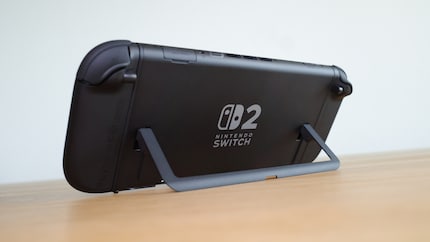
Joy-Con 2: excellent haptic feedback and successful mouse control
Nintendo has also made sensible improvements to the detachable Joy-Con controllers. They are now magnetically attached to the console. This works simply and reliably. They sit rock-solid and no longer wobble like their predecessors, which were attached to rails
The new wrist straps are also much easier to attach. With the add-on, which I attach to the magnetic rails of the Joy-Cons, I have more grip when I operate the controller halves detached from the console. The plastic parts also have another advantage: they give me more surface area and grip when I use the Joy-Cons as a mouse.
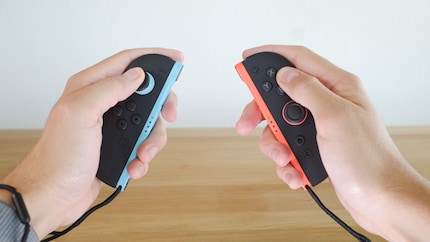
Both Joy-Con halves have a small mouse sensor built in. I'm testing this in slower strategy games like «Civilization VII», but also with the fast-paced shooter gameplay of «Cyberpunk 2077». I'm amazed at how well and precisely it works. I'm still not sure how to hold the relatively small mouse, but I'm learning and getting better. After around two hours «Cyberpunk 2077», however, I feel slight cramps in my right hand.
Nintendo claims that the mouse can also be used on trouser legs or the sofa. This is theoretically true, but it is very uncomfortable and unreliable. In my setup, I'm lucky enough to be able to use the mouse on the back of my armchair.
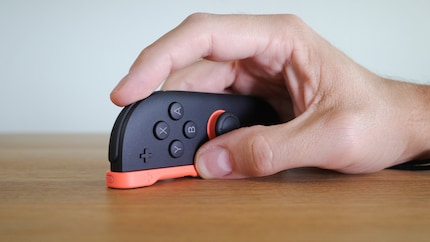
The advanced vibration motor in the controllers is also extremely successful: «HD Rumble 2». The ultra-precise and/or very strong vibrations can compete with Sony's excellent PS5 controller. In contrast to Sony's Dualsense, the battery of the Joy-Con 2 controllers «lasts forever». Before the little things give up the ghost and I have to connect them to the Switch 2 again, 19 hours and 37 minutes pass in my test.
I'm less convinced by the sticks. Although they are larger than the original, they feel less precise and too loose compared to the new Pro-Controller. The buttons on the front and the SL and SR buttons on the magnetic bar are also larger and more comfortable to click than on the previous model.
Unfortunately, there are still no analogue ZL and ZR triggers on the back, only digital buttons. This is a shame, as it makes ports of racing games that rely on precise gradations when pressing the triggers virtually impossible.
The L and R buttons, which are angled at 90 degrees, are something I notice negatively when playing «Mario Kart World». Because they are so long and have a low pressure point, I occasionally press them by mistake.
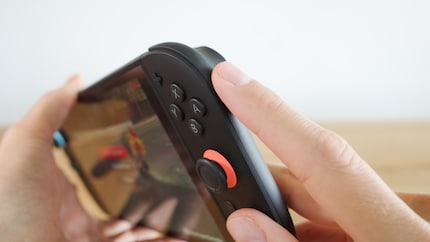
Now you're playing with power
The Switch 2 is significantly more powerful than the Switch 1. For hardcore Nintendo users like me, playing on the Switch 2 feels like a liberation. Finally, modern technology in a Nintendo console again.
The Switch 2 is equipped with a chip specially developed for Nintendo by Nvidia. Due to its form factor, the mobile hardware cannot compete with the raw power of the stationary consoles from Sony and Microsoft. However, the Switch 2 doesn't have to admit hopeless defeat thanks to access to modern rendering technologies such as ray tracing, Nvidia's DLSS upscaler and fast memory.
In general, you can expect the Switch 2 to deliver games at the graphical level between the PS4 and the Xbox Series S. Porting most current-gen games (PS5 and Xbox Series X/S) should also be possible on the Switch 2 with a few compromises.
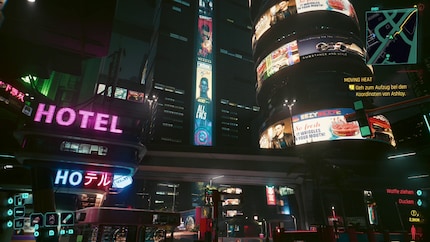
Nintendo demonstrates the power of the Switch 2 in «Mario Kart World» - 24 drivers in an open world at a constant 60 frames per second (FPS) would have been impossible on the Switch 1.
The Switch 2 upgrades of the two «The Legend of Zelda»-switch-games are also impressive. At last, the masterpieces run smoothly at 60 FPS and no longer look so blurry thanks to the higher resolution.
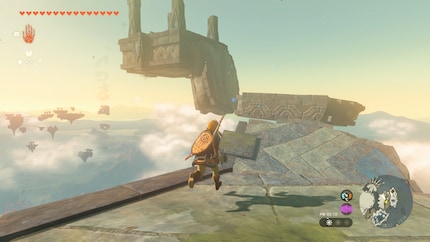
Apropos resolution: In TV mode, the Switch 2 manages a 4K output at 60 FPS via the supplied dock. With a lower resolution of 1440p or 1080p, even 120 FPS is possible.
No matter what resolution I game in, the games look excellent on my 83-inch TV compared to the Switch 1. The only downer: VRR is only supported in handheld mode and not in TV mode.
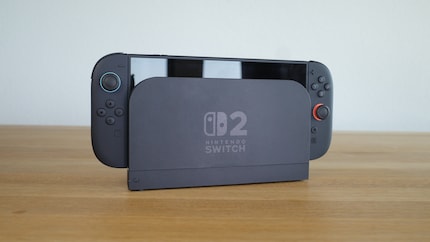
LCD: I am disappointed
If you read through the specs of the Switch 2 display, you might think that Nintendo has built an egg-laying wool-milk sow into the handheld. At 7.9 inches and a resolution of 1080p, the screen is larger and sharper than before. It also has a high refresh rate of 120 Hertz and supports VRR. Yes, the handheld can even do HDR.
The first impression is correspondingly positive. Especially in «Mario Kart World» I am impressed by the additional surface area and sharpness as well as the bright colours. However, the more I use the screen, the more negative points I notice. These mainly have to do with the fact that Nintendo is using LCD rather than OLED screen technology in the Switch 2.
The low brightness of the panel is particularly problematic, which cancels out many theoretical advantages - above all HDR - in practice.
With a peak brightness of just 450 nits, the Switch 2's LCD is poorly equipped for HDR content. Although the HDR effect is theoretically possible, it is less spectacular to the naked eye than the bright and high-contrast SDR display of the old OLED screen. To make matters worse, the black levels are generally too high due to the display's backlighting. Especially in dark scenes, the Switch 2 loses out compared to the Switch 1 OLED model with its low-contrast display.
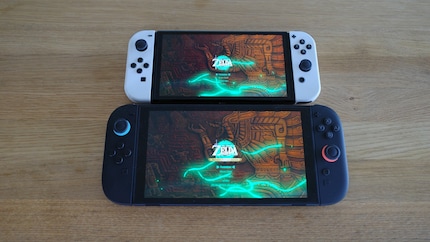
I would also like more brightness in everyday life, regardless of the HDR issue. I usually play with the Switch 2 on the train without any problems. However, when I unpack the handheld on a sunny day outdoors, I can only recognise very little in dark games such as «Cyberpunk 2077».
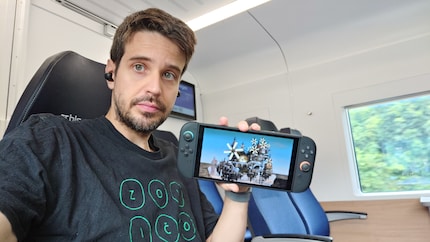
I'm also disappointed with how susceptible the screen is to scratches. Nintendo has permanently installed a plastic film on the Switch 2. This is supposed to help prevent injuries from splinters if the display breaks. After two weeks of use, I already have several large scratches in the plastic, despite the case for transporting the console.
Especially annoying: the largest of these are in the centre of the screen. At least the damage is only superficial so far. However, I can see them in direct sunlight or when I shine a torch on it. I am concerned about the longevity of the screen.
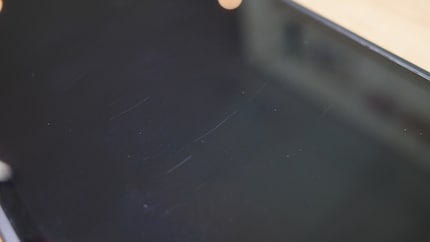
Where is the nearest power socket?
The additional power of the Switch 2 and the technical gimmicks of the display are reflected in poor battery performance. Although Nintendo has installed a 1.3 times larger battery in its next-gen handheld, in practice it lasts significantly less than the OLED model. The company officially speaks of 2 to 6.5 hours.
I test the battery with three Switch 2 games of varying graphical complexity and a Switch 1 game. For all tests, I turned up the brightness of the display and the volume of the (very good and loud) speakers. Wi-Fi is also activated - without downloads in the background.
- «Cyberpunk 2077» (Switch 2) in performance mode: 2:00h to 1 per cent.
- «Bravely Default: Flying Fairy HD Remaster» (Switch 2): 2:32h to 1 per cent.
- «Mario Kart World» (Switch 2) in online multiplayer: 1:52h to 4 per cent. I don't start a new race after that because it wouldn't last until the home straight.
- «Date Everything!» (Switch 1): 3:12h to 0 per cent. Note: Because Nintendo occasionally has problems with the correct display of the battery charge level, I decided to not only game to 1 per cent, but to drain the battery completely. That doesn't help much. With one per cent, I only continue to game for a few minutes before the Switch 2 completely gives up the ghost.
For comparison, I also play «Date Everything!» on my Switch 1 OLED model. After 3:12 hours, I still have 42 per cent battery left on this one and could probably continue playing for a few more hours.
The Switch 2's modest battery performance reminds me of the original Switch from 2017, and I'm also worried about its longevity - because the battery will go through a lot of charging cycles pretty quickly.
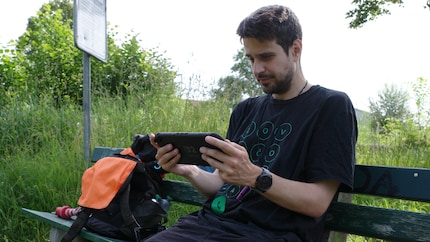
Operating system: Nintendo is not catching up, but is making progress
The operating system of the Switch 2 also reflects Nintendo's approach to the new console generation. Visually, there are only a few changes, but Nintendo scores with simplicity, sensible innovations and fun gimmicks.
The fact that the Switch 2 is almost completely compatible with Switch 1 software is particularly exemplary. It's never been easier to bring my game collection from one Nintendo generation to the next. Some Switch 1 titles get free or paid upgrades that make them run better on the Switch 2's more powerful hardware. But even games without special updates usually perform more stable, smoother and/or sharper.
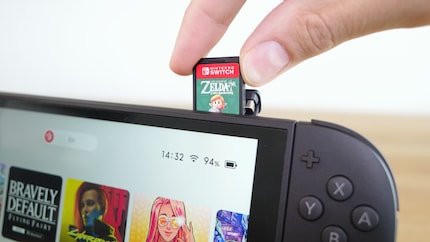
A lot has also happened in the multiplayer area. The features described below require a paid «Nintendo Switch Online» subscription. On a positive note, the price for Nintendo's online functions has not increased despite the new features and the additional Gamecube retro library (around 20 francs or euros per year for the basic subscription or around 40 francs or euros per year for the expansion pack).
With the «GameShare» function, I can start multiplayer games with another person in some compatible Switch 2 games without him or her owning a copy of the game. The game runs on my Switch 2 and is streamed to another Switch 2 - or even Switch 1. The function can be used both locally without a plan and online with a plan.
In my test, this nice gimmick basically works - but with noticeable latency, visible streaming artefacts and occasional stuttering in both variants. GameShare is less suitable for ultra-fast racing games such as «Fast Fusion», but rather for cosy multiplayer titles such as Nintendo's board game collection «51 Worldwide Games». It's not a core feature, but a nice bonus that I'll probably only rarely use.

The biggest and most important new feature in the operating system is «GameChat» - Nintendo's new chat app for the Switch 2, which I launch using the specially created C button. This allows me to chat easily with my Nintendo buddies. A huge step forward compared to the Switch 1, where I still had to launch a separate smartphone app for this.
Nintendo has built a microphone into the Switch 2 for chatting. It's amazing the quality with which I can talk to other users, even though the console is far away from me. Michelle and Simon can even hear me during the test when a hoover is running in the background. Another exemplary feature is how the Switch 2 automatically adjusts the volume of the game depending on whether there is a lot or little talking going on.
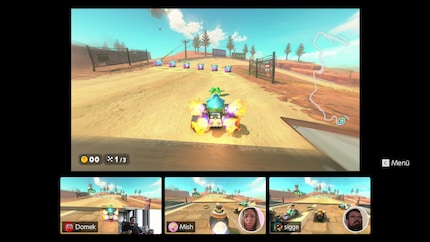
I can also choose to share my screen in GameChat or take part in the chat via video with a USB camera. Here too, the whole thing is kept as simple as possible, but works reliably.
However, simplicity also has its downside. Compared to party chats on Playstation and Xbox, I have to live with some restrictions. For example, I can't talk to strangers and there is no text input.
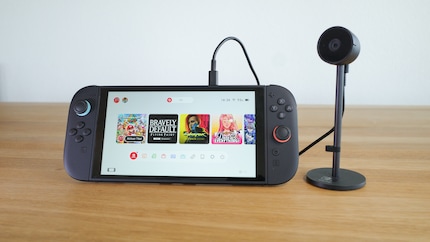
I also searched in vain for other (social) online functions of the competition, such as Discord integration, game ratings or trophies (achievements) on the Switch 2.
The latter point in particular pains me personally, not least because Nintendo keeps flirting with the idea in individual games - as in «Mario Kart World» and the two «Zelda» upgrades. Well-made achievements massively extend my playing time and also serve as nice reminders of days gone by.
In a nutshell
A successful hardware upgrade with annoying weaknesses
The Switch 2 is a bigger, faster and generally better Switch. Nintendo's handheld doesn't impress with incredibly crazy innovations, but with sensible improvements. The additional size means the handheld fits better in the hand. The Joy-Con 2 controllers have been improved all round and impress with a precise vibration function and amazingly successful mouse control.
The graphical leap from the Switch 1 to the Switch 2 is enormous. Nintendo's new console doesn't feel hopelessly outdated - on the contrary. In TV mode, games finally look acceptable even on large televisions and run smoothly - unfortunately without VRR. In handheld mode, the LCD disappoints with a big gap between theoretical functions and practical implementation. The screen is too dark for HDR - and surprisingly prone to scratches. The battery also causes me grief with its poor performance.
With excellent backwards compatibility and new functions such as GameChat, the Switch 2 is also a pleasure to use. However, the console doesn't offer quite as many functions as the competition from Sony and Microsoft.
Pro
- Lots of power in a slim, attractive package
- Revised, larger Joy-Con controller with magnetic holder
- amazingly good mouse control
- Backwards compatibility and new functions such as game chat
Contra
- scratch-sensitive LCD is too dark (for HDR)
- No VRR in the dock
- Disappointing battery performance

My love of video games was unleashed at the tender age of five by the original Gameboy. Over the years, it's grown in leaps and bounds.


